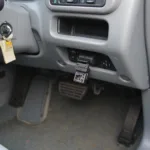Connecting multiple diagnostic tools or other devices to your car’s OBD2 port seems impossible, right? That’s where the best OBD2 splitter comes into play. These handy devices allow you to simultaneously use multiple OBD2 devices, opening up a world of possibilities for car diagnostics, data logging, and performance monitoring. Choosing the right splitter can be confusing, so we’ll guide you through everything you need to know.
Understanding the Need for an OBD2 Splitter
Why would you need an obd2 spliter? Many modern vehicles only have a single OBD2 port, which presents a challenge when you want to use more than one device at a time. For example, you might want to use a diagnostic scanner to read trouble codes while simultaneously using a GPS tracker or a performance monitor. An OBD2 splitter provides the solution by effectively multiplying your single OBD2 port.
Choosing the Right OBD2 Splitter for Your Needs
Not all OBD2 splitters are created equal. Some are designed for specific applications, while others offer broader compatibility. Consider the following factors when choosing a splitter:
- Number of Ports: Splitters come with varying numbers of ports, typically ranging from two to four. Consider how many devices you intend to connect simultaneously.
- Compatibility: Ensure the splitter is compatible with your vehicle’s OBD2 protocols. Most modern splitters support all standard OBD2 protocols, but it’s always best to double-check.
- Data Transfer Rate: If you’re using data-intensive applications, such as real-time performance monitoring, choose a splitter with a high data transfer rate to avoid lag or data loss.
- Build Quality: A durable, well-constructed splitter is essential for long-term reliability. Look for splitters with robust connectors and high-quality cables.
Benefits of Using an OBD2 Splitter
Using an OBD2 splitter can significantly enhance your car diagnostic experience. Here are some key benefits:
- Simultaneous Device Connection: Connect multiple diagnostic tools or other OBD2 devices at the same time.
- Enhanced Diagnostics: Use different tools simultaneously for a more comprehensive diagnostic approach.
- Data Logging and Performance Monitoring: Track various parameters simultaneously for detailed performance analysis.
- Convenience and Flexibility: Easily switch between different OBD2 devices without constantly plugging and unplugging.
Common Uses for OBD2 Splitters
OBD2 splitters cater to a wide range of users, from professional mechanics to DIY enthusiasts. Here are some common use cases:
- Professional Diagnostics: Mechanics can use splitters to connect multiple diagnostic tools for in-depth analysis.
- Fleet Management: Track and monitor multiple vehicles simultaneously using GPS trackers and diagnostic tools.
- Performance Tuning: Connect performance monitors and data loggers to analyze and optimize vehicle performance.
- DIY Diagnostics: Car owners can use splitters to connect diagnostic scanners and other devices for self-diagnosis.
Installing and Using an OBD2 Splitter
Installing an OBD2 splitter is typically a straightforward process. Simply plug the splitter into your vehicle’s OBD2 port, and then connect your devices to the splitter’s ports. However, it’s crucial to ensure compatibility between the splitter and the connected devices. Can obd2 read 2 devices at once? Yes, with the right splitter.
Troubleshooting OBD2 Splitter Issues
Occasionally, you might encounter issues with your OBD2 splitter. Here are some troubleshooting tips:
- Check Connections: Ensure all connections are secure and properly plugged in.
- Compatibility Issues: Verify that the splitter and connected devices are compatible with each other and your vehicle’s OBD2 protocols.
- Power Supply: Some devices might require external power, even when connected through a splitter.
- Consult the Manuals: Refer to the manuals of your splitter and connected devices for specific troubleshooting instructions.
John Smith, a certified automotive technician, advises, “When choosing an OBD2 splitter, prioritize quality and compatibility to ensure reliable performance and avoid potential diagnostic errors.”
Looking for the best obd2 splitter for bmw? Check out our dedicated guide.
Conclusion
An OBD2 splitter is a valuable tool for anyone who needs to connect multiple devices to their vehicle’s OBD2 port. By carefully considering factors such as compatibility, number of ports, and data transfer rate, you can choose the best OBD2 splitter for your specific needs and unlock the full potential of your car’s diagnostics. Plug more than 1 device into obd2 with ease and efficiency using a reliable OBD2 splitter. Perhaps you need an obd2 interpreter for a more in depth understanding?
FAQ
- Can I use an OBD2 splitter with all vehicles?
- What is the maximum number of devices I can connect to an OBD2 splitter?
- Do I need a special type of OBD2 splitter for specific diagnostic software?
- How can I tell if my OBD2 splitter is compatible with my car?
- What should I do if my OBD2 devices are not working properly with the splitter?
- Are there any risks associated with using an OBD2 splitter?
- Where can I buy a reliable OBD2 splitter?
For any further assistance, please contact us via WhatsApp: +1(641)206-8880, Email: [email protected] or visit us at 789 Elm Street, San Francisco, CA 94102, USA. Our customer support team is available 24/7.
